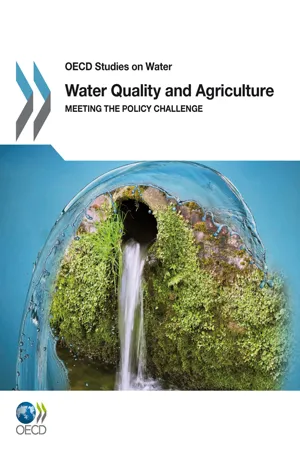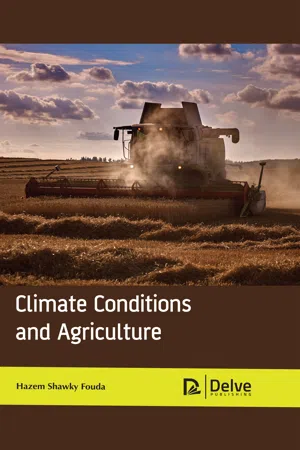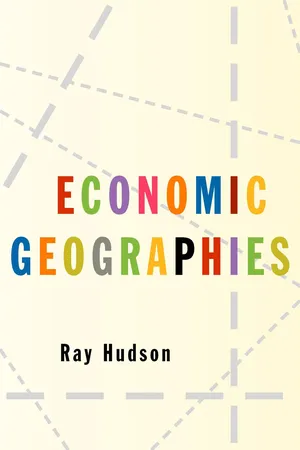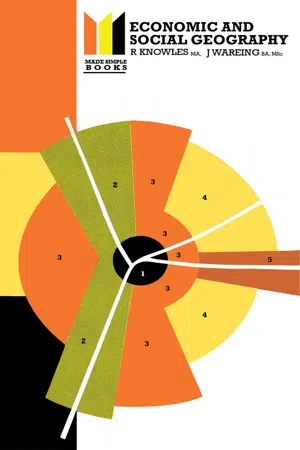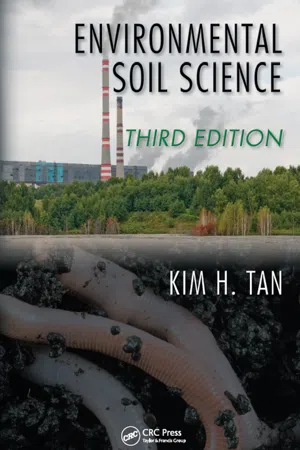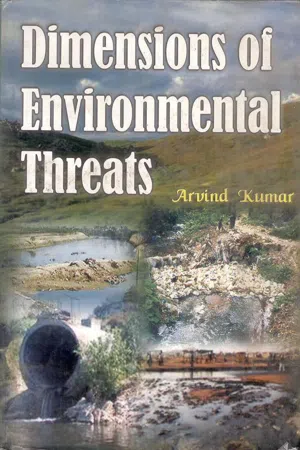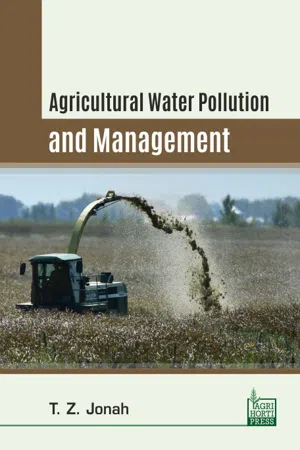Geography
Agriculture and Pollution
Agriculture can contribute to pollution through the use of chemical fertilizers and pesticides, which can contaminate water sources and soil. Livestock farming also produces methane and ammonia emissions, contributing to air pollution. Additionally, agricultural activities can lead to soil erosion and deforestation, further impacting the environment.
Written by Perlego with AI-assistance
Related key terms
1 of 5
9 Key excerpts on "Agriculture and Pollution"
- eBook - PDF
- (Author)
- 2012(Publication Date)
- IWA Publishing(Publisher)
Farming systems, however, have not been fully efficient in their use of farm inputs and intensification has led to degraded fragile soils, removal of vegetation from land, increased land drainage, and other changes altering the natural environment. These changes, combined with a great range of landscapes from mountains to floodplains, climates, rainfall patterns, soil types, and vegetative cover, have led to varying exports of nutrients, pesticides, soils and other pollutants from agriculture into water systems (Table 2.1). The pollutants are transported into surface water and groundwater through various processes including in dissolved form (leaching), pollutants attached to eroding soil sediments (runoff) and gaseous release (volatilisation) which may get deposited into water, such as from manure and pesticides (Figures 2.1 and 2.2). Sub-surface field drainage and irrigated agriculture can also heighten pollutant releases into water. This has mainly resulted in water eutrophication, soil siltation, and chemical deterioration of water (e.g. from nutrients, pesticides, salts, pharmaceuticals and chemical farm wastes). Under certain farm management practices and systems, however, agriculture can be beneficial to water quality, or cause little impact on water systems, as previously discussed. Elevated levels of pollutants from agriculture have damaging effects on the following (Table 2.1; Chapter 3). • Environment , this includes not only aquatic ecosystems (e.g. from wetland to marine ecosystems) but also fauna dependent on the viability of these ecosystems. • Agriculture fisheries and other commercial users , both fresh and marine water fisheries, and other commercial water uses. • Non-consumptive values of water systems ; mainly recreational uses (e.g. swimming), visual (waterscapes), and social values (e.g. spiritual). • Human health , mainly through contaminants in drinking water and the quality of bathing water. - eBook - ePub
Human Ecology
The Story of Our Place in Nature from Prehistory to the Present
- Bernard Campbell(Author)
- 2017(Publication Date)
- Routledge(Publisher)
In summary, the development of agriculture is the first of the major cultural advances that has transformed the biosphere by permitting an immense multiplication of the human species. Agriculture has made possible civilization and given humans the opportunity for leisure. It has freed the human spirit from the endless search for food and shelter.Agriculture has thus been of unquestionable benefit to humanity, but in our attempt to extract more and more resources from our environment by removing the limiting factors of water, mineral availability and the parasites and predators of plants (as well as animals), we have developed chemical products which are proving very damaging to the planet. All the major rivers of N. America, Europe and Asia are seriously polluted, and in the USA 64% of the pollutants are of direct agricultural origin.Humans themselves also generate toxic wastes, either directly, or through their industries. In India, the rivers, including the sacred Ganges, are little more than open sewers. 600 km of the Ganges are dangerously polluted with human and animal wastes together with an increasing amount of the toxic and hazardous effluent from industry and agriculture. Fifty-four out of 78 major rivers in China are seriously polluted with sewage and industrial wastes.There is some reason to believe that a growing awareness of this terrible problem is engendering a response among politicians who at last are beginning to vote the large sums of money needed for the installation of water treatment plants. But we have a very long way to go to transform and recycle the waste products of over 5 billion people.REFERENCES
1 . Conklin, H. C. 1969 An Ethnoecological Approach to Shifting Agriculture. In Environment and Cultural Behavior A. P. Vayda, ed. (New York: Natural History Press).2 . Leach, G. 1976 Energy and Food Production (London: IPC Press).3 . Richards, L. A. 1969 Saline and Alkali Soils (Washington: US Department of Agriculture).4 . Wahab, A. 1964 The Soil Problems of West Pakistan. In The Role of Science in the Development of Natural Resources, with Particular Reference to Pakistan, Iran and Turkey - eBook - ePub
Dirty Words
Writings on the History and Culture of Pollution
- Hannah Bradby(Author)
- 2013(Publication Date)
- Routledge(Publisher)
CHAPTER FIVE AGRICULTURAL POLLUTION: THE PRICE OF PROGRESS? JANET ROWE EARLY DAYS: A NECESSARY BALANCE WITH NATURESince neolithic times, people and their agricultural activities have had a profound effect upon the environment of what is now the UK. As the hunter-gatherers gave way to herders and cultivators, the land surface was progressively cleared of the wildwood. The earliest revolution in land-use came with the discovery that if land was fallowed, or rested for a season or more, it could be kept in cultivation. This allowed settlement, and increases in population. Drier and more accessible areas came first into agriculture. Soils in some of these situations were thin and prone to erosion, for example over the chalk, or in sandy areas, or where underlain by impermeable rocks. If cultivation occurred, it was relatively short-lived, and re-colonization by bushes and trees was only patchy. Animals could be extensively grazed, however, often with the associated use of more fertile pastures. It is largely this management which has given us the downlands, heathlands and moorlands of today.On heavier, more fertile land, a pattern of open fields, usually strip-farmed, meadows and commons, copses and woodlands developed, all useful and managed for products of different kinds. Such mixed farming and extensive management has given us our ancient woodlands, hedgerows and lowland meadows. Enclosure in the eighteenth and nineteenth centuries, as population increased and there were greater profits to be made from more advanced stock-rearing and cropping methods, changed the patterns and gave us more hedgerows and walls; but rotation and inter-relationship between the different facets of land management were still essential. There was little except marl and lime which could be brought in to assist production, so resources had to be safe-guarded. - eBook - PDF
- Hazem Shawky Fouda(Author)
- 2019(Publication Date)
- Delve Publishing(Publisher)
Climate Conditions and Agriculture 188 living, biotic components. Environmental degradation has been accelerated by increases in population, industrialization, agricultural mechanization and inappropriate land use polices. As the population increases the damages made on available resources also increase. There is extensive clearing of land for agriculture and settlement. Traditional land and resource management systems are no longer able to adapt fast enough to prevent over-use of the available resources (Nath, 2009). Rapid population growth has led to more people moving from rural areas because of shortage of land, to the urban areas, swelling the urban population to record proportions and overwhelming the existing services and infrastructure. This also puts pressure on the available land in urban areas and this leads to a deterioration of the environment. Apart from population spilling to urban areas there has also been spill-over to the ecologically fragile marginal areas. Figure 9.5: There have been reports of growing global environment crises of the green-house effects, polluted lakes, rivers and seas all these leading to de-terioration in the quality of life and threatening actual human health and exis-tence. Source: http://www.greenpeace.org/eastasia/campaigns/toxics/problems/water-pollution/ Increasing agricultural technology is causing water and soil pollution making it dangerous for human consumption. While all these forms of environmental degradation have been taking place, women have been placed Environmental Management in Relation to Agricultural Practices 189 at the center of the controversy, whether they are to blame for environmental degradation or they are victims of environmental degradation, especially in the Third World (Nath, 2009). 9.7. KEY INDUSTRIES THAT POLLUTE THE ENVIRONMENT 9.7.1 The Coffee Industry Coffee processing industries are reputed to be the greatest source of water polluting in developing countries. - eBook - PDF
Economic Geographies
Circuits, Flows and Spaces
- Ray Hudson(Author)
- 2005(Publication Date)
- SAGE Publications Ltd(Publisher)
The growth of complex urban industrial economies continues to have severe localised effects. In many parts of the world, processes of urbanisation and the resultant expansion of the built environment are leading to the further 190 ECONOMIC GEOGRAPHIES FROM SPACES OF POLLUTION AND WASTE TO SUSTAINABLE SPACES? 191 FIGURE 10.1 From a pulluted space to a sustainable space? The Green side of Teesside, England substantial conversion of rural to urban land and the destruction of natural environments and ecologies. These processes are currently perhaps most sharply expressed in the explosion of massive urban areas over much of South America and south-east Asia but are far from confined to there. For example, between 1980 and 1990 almost 14% of land ‘previously considered to be part of natural cover was lost to urban development and housing’ in 11 countries of the European Union (Commission of the European Communities, 2001, 26). In addition, the amount of land converted to road space increased by 11% between 1980 and 1998. Modern ‘industrial’ agricultural practices can cause severe localised pollu-tion (for example, via production of organic wastes) and also generate more widespread unintended environmental effects, such as increased soil erosion and silting of rivers and fertiliser pollution of inland waters. Nitrates can no longer be held down by the colloids of vegetal soil and are carried away by running water to accumulate in coastal waters and lakes (Deléage, 1994, 40). Even more seriously, modern agriculture can involve deliberate wholesale ecological destruction. For example, clearing equatorial rainforest to provide cattle ranches markedly reduces genetic variety, bio-diversity and species diversity (Yearley, 1995a). The result can be extensive spaces of waste. This tendency has recently been given a further twist. - eBook - PDF
- R. Knowles, J. Wareing(Authors)
- 2014(Publication Date)
- Made Simple(Publisher)
PART ONE: THE STUDY OF ECONOMIC AND SOCIAL GEOGRAPHY CHAPTER ONE MAN AND ENVIRONMENT Geography is currently going through an exciting period in its development as new problems are identified and new methods of analysis are formulated. It is not easy to say precisely what geography is about because geographers often hold different views of the subject, and these views change from time to time, but this is not surprising since geographers are interested in a very wide range of problems and rapid advances are being made in the subject, as they are in all branches of knowledge. Because geography involves such a wide range of knowledge, the subject has been divided into two major areas of study. The first of these is physical geography, which is concerned with the physical environment of landforms, weather and climate, soils, and plants and animals (see Physical Geography Made Simple). The second is human geography, which is concerned with man's activities over the surface of the earth. In many ways this is a false distinction since the activities of man take place within the physical environment, and the physical environment is considerably affected by these activities, but the divi-sion is a useful one and in this book the physical environment will only be considered in relation to man. Human geography can be studied in two principal ways. First, the earth's surface can be studied part by part. This is the approach of regional geography, which seeks to understand the unique character of an area as produced by the interaction of human activity and the physical environment. Secondly, human activity over the earth's surface can be studied part by part. This is the approach of systematic geography, which isolates particular elements such as agriculture, industry or transport, and seeks to understand their spatial patterns and the processes which have produced them. - eBook - PDF
- Kim H. Tan(Author)
- 2009(Publication Date)
- CRC Press(Publisher)
The soil is traditionally the site for disposal of all these wastes, and people have been discarding waste since prehistoric times. However, there was little concern in the old days about pollution because the human population was not that large and there was plenty of space on earth for the amount of waste produced. However, with population growth and the revolutions in industry and agriculture, huge amounts of waste and a variety of new Soil and Pollution 427 types of pollutants have been produced. For example, beef cattle in the United States was estimated to produce 92 million and dairy cattle 27 million metric tons/yr of manure (Donahue et al., 1983). Some of these types of wastes are difficult to deal with because of their diffuse or nonpoint nature, such as manure deposited at random by livestock, which may be washed into nearby streams (Troeh et al., 1980). The introduction of waste into the soil may result in soil contamination or pollution, and as indicated in Chapter 8 , many people do not make a distinction between contamination and pollution. They often use the terms interchangeably, though some believe that these are two distinct phenomena, though related to each other (Wild, 1993). As defined earlier, soil contamination is the result of the addition of hazardous substances without endangering the environment. The mere presence of a toxic substance may not be a problem, though it may create some concern for pollution upon further accumulation of the material. Therefore, a high degree of contamination may cause pollution. Pollution, then, refers to the addition of substances resulting in degradation of soils and the environment. For example, manure deposited randomly by livestock in the field is a form of contamination, but manure accumulated in feedlots is distinctly polluting the area. Because of concern about contamination and especially the degradation in environmental quality starting in 1970, a number of methods of waste disposal were explored. - eBook - PDF
- Kumar, Arvind(Authors)
- 2021(Publication Date)
- Daya Publishing House(Publisher)
6 ENVIRONMENT DEGRADATION IN AGRICULTURE Avtar Singh & J.S. Kang ABSTRACT Human activities are mainly involved in degradation of environment like population, agriculture waste burning, over consumption of resources, failure to recycle of waste, disposal of toxic wastes, misuse of chemicals, depletion of soils by over farming, erosion from removal of vegetation, removal of carbon sink (trees), inefficient use of fuel and non-sustainable cropping systems. Increase in population is also affect the food security and improper disposal of human excreta, garbage, over crowding, urbanization of farm land and water shortage play important role in environment pollution and ecological imbalance. From the one decade the agricultural scenario has been changed because the rate of increase in food production has declined. Better management in terms of excessive use of inorganic fertilizers, chemicals for plant protection measures and irrigation water have up set ecological balance causing major changes in the ecosystem and biosphere. Thus, farmers are facing serious problems of declining underground water-table, deterioration of This ebook is exclusively for this university only. Cannot be resold/distributed. soil health, emergence of new pests, diseases, weeds and environment pollution. Introduction Clean and safe environment is essential for better living. However, environment degradation is the serious problem of now-a-days. Environment degradation is the result of development in agriculture, urbanization and industrialization. In fact the development of high input technology for the increase in agriculture production plays a crucial role in the degradation of environment during the past four decades in terms of depletion of water-table, deterioration of soils, infestation of weeds, emergence of new insects, pests and diseases, environment pollution and ecological imbalance. - eBook - PDF
- Jonah, T Z(Authors)
- 2018(Publication Date)
- Agri Horti Press(Publisher)
However, there are costs associated with high-yield methods, including their heavy reliance on pesticides and fertilizers. Runoff of fertilizers from agricultural lands has affected the water quality of some lakes, rivers, and bays. Erosion is, and has been since crops were first planted, a serious environmental problem in the absence of preventative measures. Irrigation, required in many parts of the world, can be a significant drain on water supplies in arid areas and, if improperly managed, can lead to buildup of salt deposits, which may severely degrade soil quality. One of the most critical challenges of the next few decades is to find ways to increase production of food while minimizing environmental degradation. Considerable research in this and other countries has led to advanced methods to preserve soil and prevent erosion, including conservation tilling and computer-controlled application of pesticides, fertilizers, and water. Pesticide use is controversial. Other methods, especially new types of genetic modification, or “genetic engineering” are more controversial. To reduce reliance on pesticides, methods such as biocontrol (using other species to control pests) and biotechnology to create pest-resistant crops are being tested. Biocontrol using wild-type (naturally occurring) species This ebook is exclusively for this university only. Cannot be resold/distributed. 180 Agricultural Water Pollution and Management is usually accepted, especially by organic producers. Naturally occurring mutants are accepted as well. More controversial is the use of genetically modified biocontrol agents changed by DNA deletion or insertion of new traits. Concerns about the potential impacts of these methods have been raised. Environment and Society Throughout history humans have both affected, and been affected by, the natural world.
Index pages curate the most relevant extracts from our library of academic textbooks. They’ve been created using an in-house natural language model (NLM), each adding context and meaning to key research topics.
